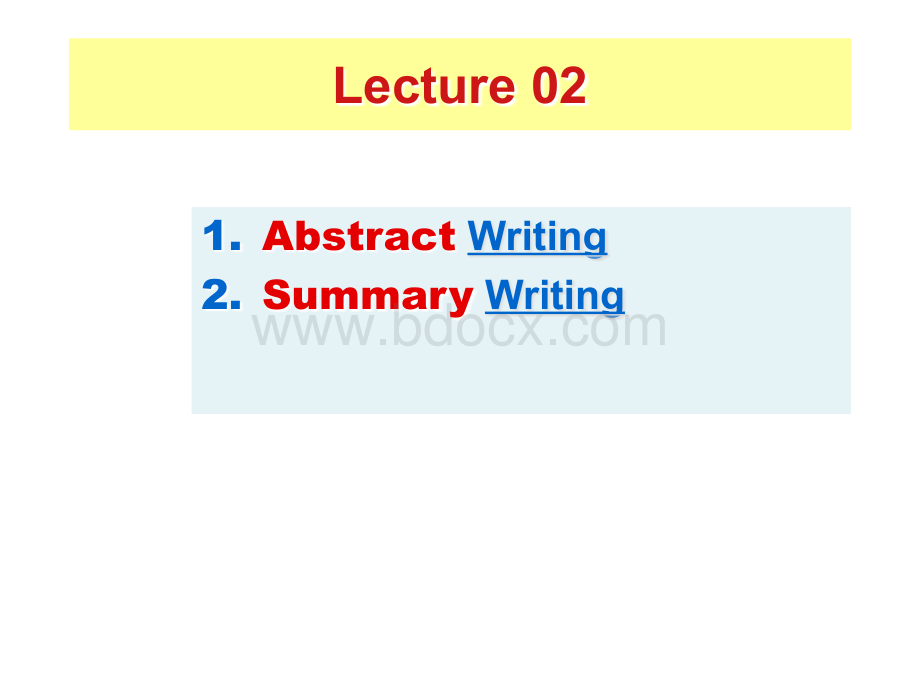科技英语摘要Writing-Abstract&summaryPPT文件格式下载.ppt
《科技英语摘要Writing-Abstract&summaryPPT文件格式下载.ppt》由会员分享,可在线阅读,更多相关《科技英语摘要Writing-Abstract&summaryPPT文件格式下载.ppt(52页珍藏版)》请在冰豆网上搜索。

itisageneralmapforreaders.MichaelAlley1.Definitionoftheabstract
(1)AnAbstractshouldbeviewedasaminiversionofthepaper.Theabstractshouldprovideabriefsummaryofeachofthemainsectionsofthepaper:
Introduction,Introduction,MaterialsandMethods,ResultsandDiscussionMaterialsandMethods,ResultsandDiscussion.Generallyspeaking,theabstractshouldnotexceed250words(100-200words)andshouldbedesignedtodefineclearlywhatisdealtwithinthepaper.1.Definitionoftheabstract
(2)Theabstractshould:
(1)statetheprincipalobjectivesprincipalobjectivesandscopescopeoftheinvestigation,
(2)describethemethodologymethodologyemployed,(3)summarizetheresultsresults,and(4)statetheprincipalconclusionconclusion.1.Definitionoftheabstract(3)MostoftheAbstractsshouldbewritteninthepasttense,becauseitreferstoworkdone.Theabstractshouldnevergiveanyinformationorconclusionthatisnotstatedinthepaper.ReferencestotheliteraturemustnotbecitedintheAbstract.2.Typesofabstracts
(1)InformativeabstractInformativeabstract(moredetailed,andmayincludequantitativedetails)信息性/报道性/资料性摘要Indicative/descriptiveabstractIndicative/descriptiveabstract(briefandqualitative,indicatingwhatkindofresearchhasbeendone)指示性/说明性/描述性摘要Informative-indicativeabstractInformative-indicativeabstract报道-指示性摘要2.Typesofabstracts
(2)AneffectivediscussionofthevarioususesandtypesofabstractswasprovidedbyMcGirr(1973),whoseconclusionsarewellworthrepeating:
“Whenwritingtheabstract,rememberthatitwillbepublishedbyitself,andshouldbeself-contained.Thatis,itshouldcontainnobibliographic,figure,ortablereferences.”2.Typesofabstracts(3)Thelanguageshouldbefamiliartothepotentialreader.Omitobscureabbreviationsandacronyms.Writethepaperbeforeyouwritetheabstract,ifatallpossible.UnlessalongtermisusedseveraltimeswithinanAbstract,donotabbreviatetheterm.Waitandintroducetheappropriateabbreviationatfirstuseinthetext(probablyintheIntroduction).2.1Informativeabstract2.1Informativeabstract信息性/报道性/资料性摘要Aninformativeabstractisdesignedtocondensethepaper.Itcanandshouldbrieflystatetheproblem,themethodusedtostudytheproblem,andtheprincipaldataandconclusions.Often,theabstractsupplantstheneedforreadingthefullpaper;
withoutsuchabstracts,scientistswouldnotbeabletokeepupinactiveareasofresearch.Thisisthetypeofabstractthatisusedasa“heading”inmostjournalstoday.2.2Indicativeabstract
(1)2.2Indicativeabstract
(1)指示性/说明性/描述性摘要Anothercommontypeofabstractistheindicativeabstract(sometimescalledadescriptiveabstract).Thistypeofabstractisdesignedtoindicatethesubjectsdealtwithinapaper,makingiteasyforpotentialreaderstodecidewhethertoreadthepaper.However,becauseofitsdescriptiveratherthansubstantivenature,itcanseldomserveasasubstituteforthefullpaper.2.2Indicativeabstract
(2)2.2Indicativeabstract
(2)指示性/说明性/描述性摘要Thus,indicativeabstractsshouldnotbeusedas“heading”abstractsinresearchpapers,buttheymaybeusedinothertypesofpublications(reviewpapers,conferencereports,thegovernmentreportliterature,etc.);
suchindicativeabstractsareoftenofgreatvaluetoreferencelibrarians.2.3Informative-indicativeabstract2.3Informative-indicativeabstract报道-指示性摘要Aninformative-indicativeabstractisacombinedformthatbearsaspecificinformationabouttheprincipalfindingsandresultsprincipalfindingsandresultsandgeneralinformationabouttherestofthedocumenttherestofthedocument.Thistypeofabstractoffersfewerdetailsfewerdetails,instead,givingemphasistotheauthorschiefcontributiontheauthorschiefcontribution.2.4Structuredabstract2.4Structuredabstract(结构式摘要)
(1)目的目的目的目的(Objective):
研究的问题、目的或设想等;
(2)设计设计设计设计(Design):
研究的基本设计,样本的选择;
(3)单位单位单位单位(Setting):
开展研究的单位;
(4)对象对象对象对象(Patients,Participants):
研究对象的信息;
(5)处置处置处置处置(Interventions):
处置方法;
(6)主要结果测定主要结果测定主要结果测定主要结果测定(MainOutcomeMeasures):
实验过程;
(7)结果结果结果结果(Results):
研究的主要发现;
(8)结论结论结论结论(Conclusions):
主要结论及其潜在应用TypesofstructuredabstractTypesofstructuredabstractNewEnglandJournalofMedicine4Parts:
Background,Methods,Results,ConclusionsBackground,Methods,Results,ConclusionsTheLancet(TheLancetistheworldsleadinggeneralmedicaljournalandspecialtyjournalsinOncology(肿瘤学),NeurologyandInfectiousDiseases.)4Parts:
Background,Methods,Findings,InterpretationBackground,Methods,Findings,InterpretationJAMA(JournaloftheAmericanMedicalAssociation)9Parts:
Context,Context,Objective,Objective,Design,Design,Setting,Setting,Patients,P